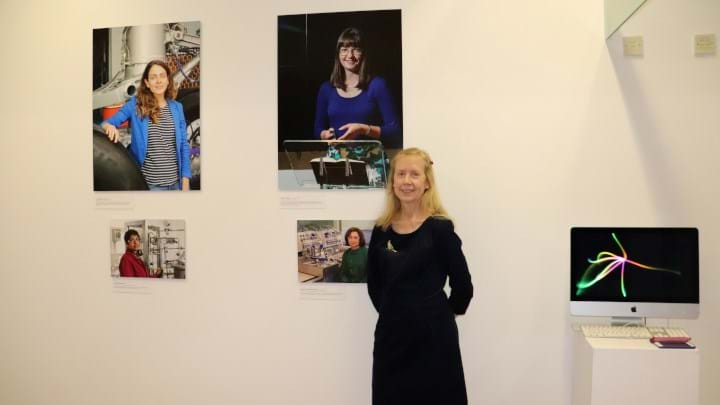Derby exhibition showcases women in engineering

THE University of Derby, UK is currently hosting a photography exhibit entitled Women Engineers – portraits of the changing face of engineering. Located at Derby’s Markeaton Street Campus, the exhibit will be open and free to visit until 23 March.
Freelance Photographer Geraldine Curtis spent two years not only photographing the women whose images are showcased, but also learning more about them, their backgrounds and careers, and about the engineering field and its diversity. Chemical engineers are amongst those featured in the exhibit, including members of IChemE.
I caught up with Curtis at a private viewing of her exhibit – held on 6 February at the University of Derby, UK – to discuss her work and impressions of women in engineering. The conversation was lightly edited for length and clarity.
What made you choose to focus on engineering as a project focus?
It was just a chance conversation with a group of women engineers. The engineers that I talked to said that less than 13% of all engineers are women, but when they talked about what they did, they said they had travelled the world, they’d done incredible things, they changed jobs quite frequently, and they had been quite mobile in their jobs – for me, that’s quite an interesting aspect of things. And, I was looking for a project to do that might encourage people to do something.
Why did you think this was an important project to do?
It’s so important because there aren’t enough women engineers, and women engineers bring an awful lot of skills that male counterparts don’t have in the way they approach problems. Engineering is generally about problem solving, and men tend to solve a problem one way, and women will see it from a different angle.
It’s also about, whether it’s fair that there aren’t enough. I was asking the question myself: why aren’t there more women engineers? And, it’s just because people don’t know. It’s just a lack of knowledge. There’s nobody out there saying, “your child could be an engineer. They could travel the world and do really interesting things.” There’s nobody really telling them that, so this is my head above the parapet saying look, look at these women.
Did your opinion of engineering, or women in engineering, change during the course of your project?
I think when I started, I had a completely blank slate; I didn’t know anything about women engineers, and I didn’t know what obstacles they face.
I was so lucky to get a response from older engineers and younger engineers; the response from the older ones included quite a few tales of all the obstacles they’ve faced and the prejudices they’ve had to overcome; whereas the younger ones say that, generally, working in a male environment they are only further encouraged, and their opinion is always valued, and they have absolutely no trouble.
There is huge progress, and that’s just wonderful. And, that’s why more women should be engineers, because they will find hardly any barriers, nowadays. It’s more or less an even playing field.
Why do you think visibility of women in engineering is important?
I think that the numbers speak for themselves. If there are only 13% of engineers who are women, why is that? We need to shout about women in engineering much more.
What outcome do you hope your project achieves?
I hope that more women/girls will consider engineering as a career.
Yasmin Ali, an IChemE member and Energy Innovation Project Manager at the Department for Business, Energy, and Industrial Strategy, was one of the subjects involved in Curtis’s project. I asked her about the importance of promoting women in engineering and enabling visibility.
What’s your opinion on the exhibition?
I think it changes the image of engineering. I speak to a lot of kids and members of the public, and I ask them “what do you think an engineer does?” and the most common answer I get is “fix a car”. Geraldine’s photos just show you the diversity, and that it’s not just about fixing cars.
And, I quite like that she’s bringing science and art together, bringing photography and engineering together. Breaking down the barriers between those two communities.
Why did you choose to get involved in the project?
To promote engineering and to show young women who are thinking about doing engineering that it’s a viable career option for them, and it’s so that they can see some role models in whose footsteps they could follow.
Why is the visibility of women in engineering important?
I think it’s hard to imagine yourself doing something if you can’t see somebody that’s like you. I find that as well. There are senior women engineers who I look up to, and I think without them I wouldn’t be able to see myself doing the things I want to do or aspire to those things.
I think I’d like to see this work exhibited in other places so it can have a bigger impact. It would be great if other universities or public spaces, did something similar to what Derby is doing.
Further to her exhibition, Curtis said she is putting together a book which will include more information about the lives and career paths of the women she photographed. This will appear in a timeline format – a good method for allowing children to take in information, she says. The book will also include many more photos of the women engineers which weren’t included in the photo exhibit.
Recent Editions
Catch up on the latest news, views and jobs from The Chemical Engineer. Below are the four latest issues. View a wider selection of the archive from within the Magazine section of this site.




